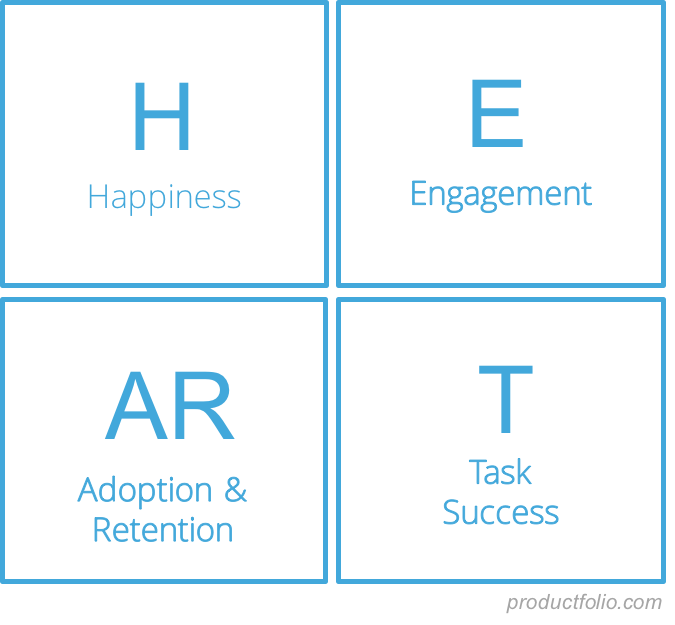Google’s Heart Framework is a metric that helps you to monitor the quality of the user experience. Heart is an acronym that stands for Happiness, Engagements, Adoption, Retention and Task Success. It’s referred to as Google’s Heart Framework because it was created at Google by Kerry Rodden, Hilary Hutchinson and Xin Fu who work in Google’s research team.
The research team at Google created the Heart Framework for large scale metrics when they realized the only measurable metrics that existed were for measuring user experience on a small scale. Small scale metrics can be done relatively easily by engaging with various users and there are a number of small scale frameworks that are commonly used. Let’s take a look at each metric in the Heart Framework.

Happiness
This metric focuses on overall user satisfaction. Since the Heart Framework is most often applied to larger-scale Products surveys are a common measure of user happiness.
Engagement
User engagement can be measured with things like use frequency, intensity, and depth of use over a period of time. The number of visits of a 30 day period of time, number of clicks in particular section, and overall time spent on a product are examples of measurable engagement.
Adoption
Adoption is the measurement of new users of a period of time. This metric helps to quantify how well you’ve attracted new business. The measurement is best gauged of a period of time so that you can determine if the adoption is due to marketing or due to the product itself. If you acquire new users based on marketing alone, they will drop off over time.
Retention
This metric is based on keeping your users for a specified amount of time, while also measuring the rate at which your users are returning. On the flip side, it’s sometimes referred to measure the failure to retain users which is referred to as a “churn rate”.
Task Success
The final metric “task success” is sometimes considered more of an engineering metric than a UX/product metric. Task Success measures things like how long it takes for search results to appear, the checkout process or length of time to load a photo. Task Success is more focused on determining the technical functionality of the product than the UX portion. This metric helps to determine the behavioral metrics of the user experience.
The HEART framework is based on goals rather than concerns, and often the Goals-Signals-Metrics (GSM) process is applied to products.
Goals
It’s important to identify your goal(s) so that the metrics help you to measure your progress towards your end goal.
Signals
Map out the key signals that you’re wanting to track. It could be anything from the number of users of a specified period of time to the number of uploads on a given day.
Metrics
Once the signals have been identified you can do A/B testing with the HEART metrics, further refining until you reach your overall goal.
The HEART framework is a great framework to apply because it is simple and straightforward. The original creation of HEART was for large scale projects, but it can also be scaled down to smaller projects with a few adjustments. To take a deeper look at the HEART Framework you can read up on it on Google.


